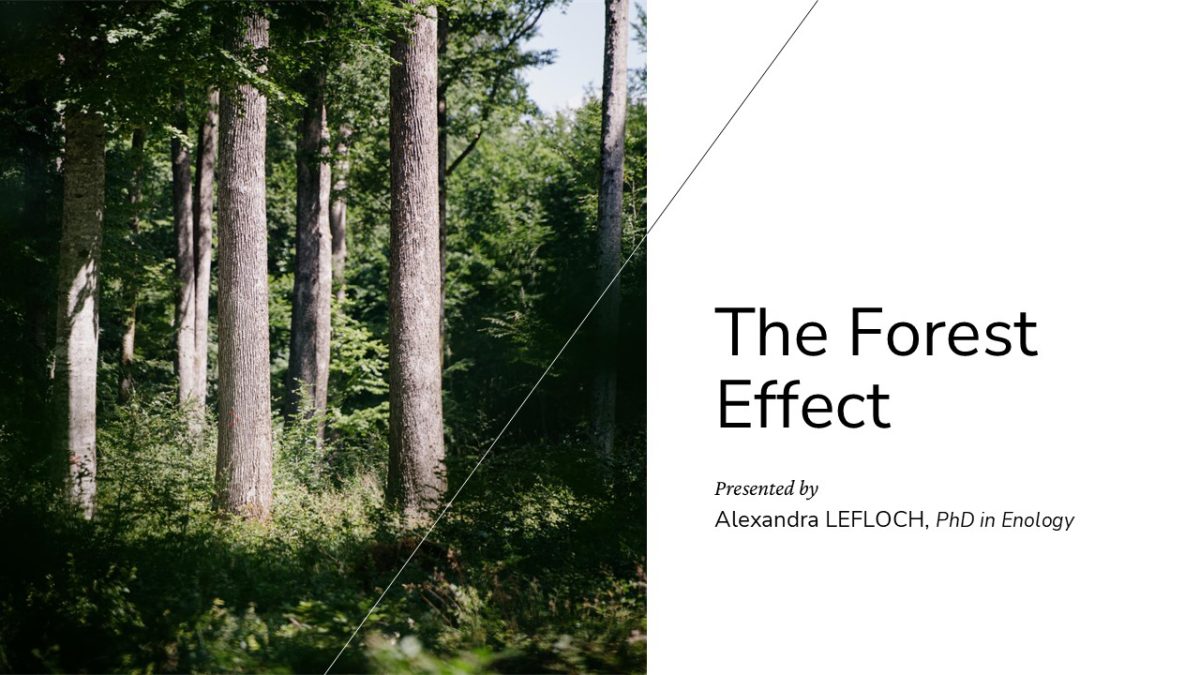The research and insights contained in this paper are the intellectual property of Cooperages 1912. Use or reproduction without prior written consent is prohibited.
The Forest Effect: How French Forest Origins Shape the Sensory and Chemical Evolution of Wine
Written by Alexandra LEFLOCH, PhD in Enology
INTRODUCTION
French Forest Heritage
French Forest Timeline
French Oak Species and Forest Terroir
EXPERIMENTAL DESIGN
Chemical Analysis
Sensory Results
Conclusion
Introduction
Coopers have long recognized the importance of forest origin in shaping the sensory qualities of wine, yet relatively little research has been conducted to understand the underlying factors driving these effects. With access to oak sourced directly from several prestigious and historically significant French forests through our company-owned stave mill in northeastern France, we saw a unique opportunity to investigate how forest terroir contributes to wine expression. This study was conducted for our TW Boswell brand of French oak barrels and aimed to evaluate whether specific forest origins impart distinct chemical and sensory characteristics to wine. We selected three single-origin forests – Allier, Tronçais, and Nièvre and a blend composed of Bertranges, Bercé, and Russy – to compare the influence of each on wine aged in barrels crafted with TW Boswell’s proprietary toasting profiles. Our goal was to better understand the role of forest variability in cooperage and its nuanced effects on wine development.
French Forest Heritage
To appreciate the excellence of modern French cooperage, we need to go back to the 17th century. In 1669, Jean-Baptiste Colbert, Minister of Finance under Louis XIV, enacted the Ordonnance des Eaux et Forêts. This legislation established sustainable forest management practices intended to support the Royal Navy with elite oak, and it shaped iconic forests such as Tronçais, Bercé, and Bertranges.
French Forest Timeline
Starting in the 12th century and certainly by the 16th century, France had begun formalizing forest rules to secure a long-term wood supply. However, the major change came in the 17th century under Louis XIV, with Colbert’s Ordonnance des Eaux et Forêts. It formalized sustainable forest management and is still considered the foundation of modern forestry in France. Today, France boasts over 16 million hectares of forest, with approximately 75% sustainably managed by the Office National des Forêts (ONF), a public body created in 1964. Thanks to the work of the ONF, the forests in France have increased by 21% since 1985.

Roughly three-quarters of French forestland is privately owned, while the remaining 25% falls under public ownership (state or communal forests). The predominant species within these forests is oak (Quercus spp.), which accounts for nearly one-third of forest cover and is one of the reasons France remains such a key player in cooperage wood supply.
French Oak Species and Forest Terroir
Cooperage oak primarily comes from two species: Quercus petraea (sessile oak) and Quercus robur (pedunculate oak). Though both belong to the same genus, they differ in leaf shape, acorn attachment, and wood composition. Sessile oak contains more aromatic compounds and fewer tannins, making it better suited for wine aging. In contrast, pedunculate oak has higher tannin content and is more appropriate for spirit aging.
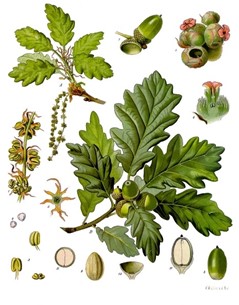
Figure 1 – Quercus petraea (sessile oak)
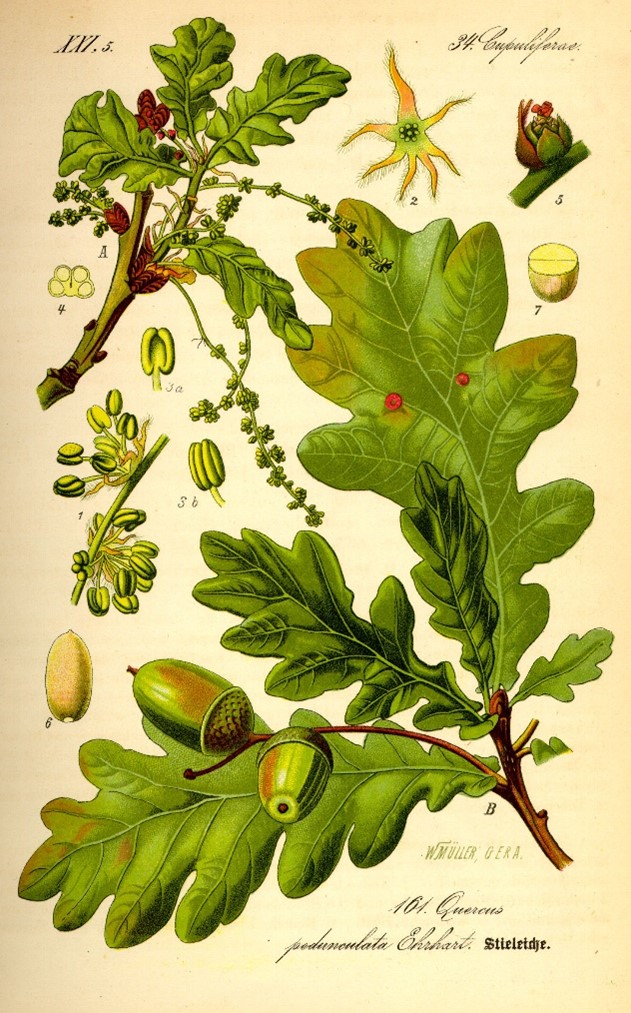
Figure 2 – Quercus robur (pedunculate oak)
For this study, we focused on three single-origin forests: Allier, Tronçais, and Nièvre; and a blend of three additional forests — Bertranges, Bercé, and Russy. These forests were chosen because of their historical legacy, sustainable management, and the consistent quality of oak they produce – ideal for long and elegant aging of wine.
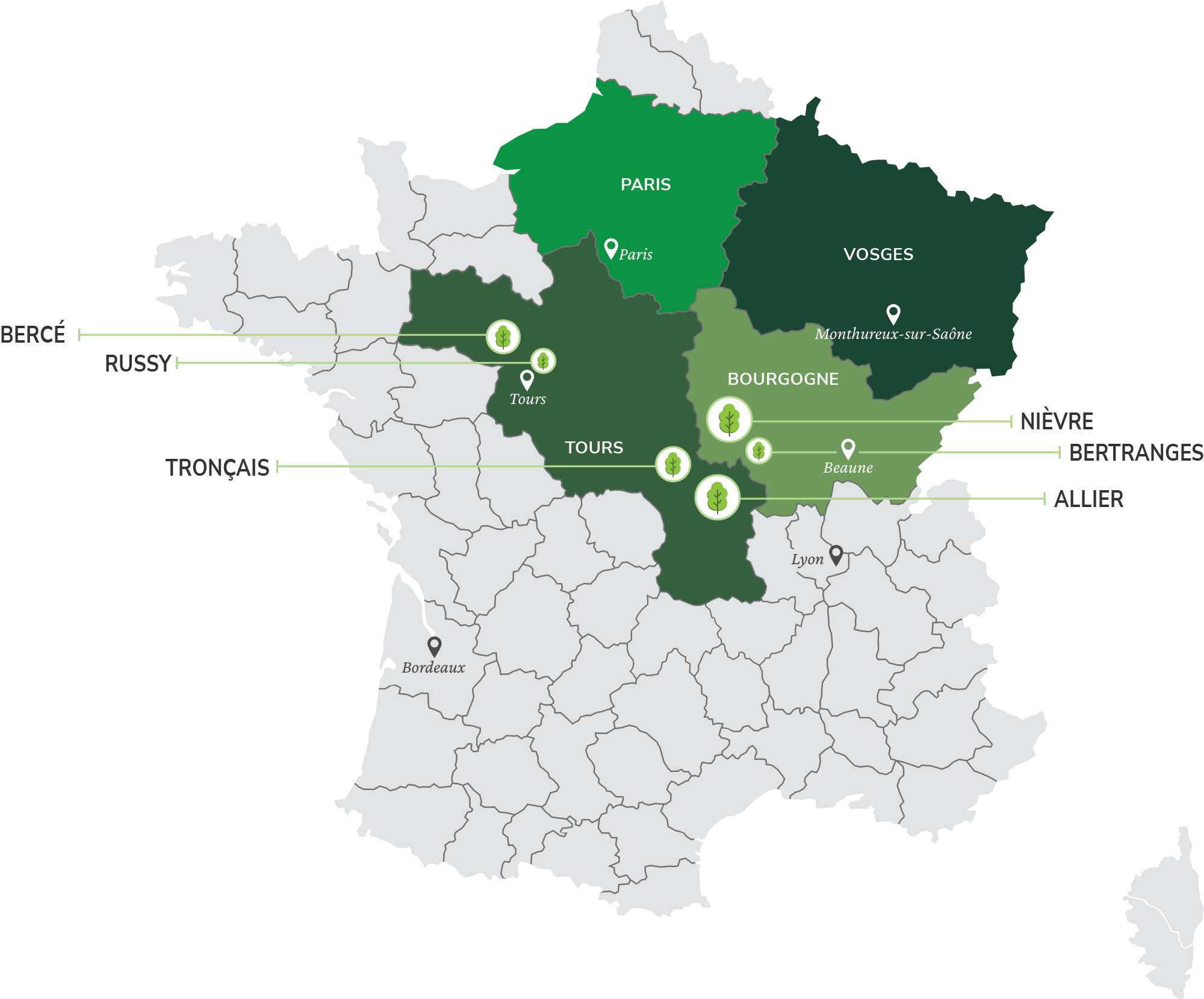
Figure 3 – Map of French Forests
Forest terroir, much like that of vineyards, is shaped by variables such as soil composition, drainage, and climate. These environmental factors influence tree growth, grain structure, and chemical composition, which in turn affect barrel performance and wine expression.
Figure 4 illustrates how growing conditions vary across forests.
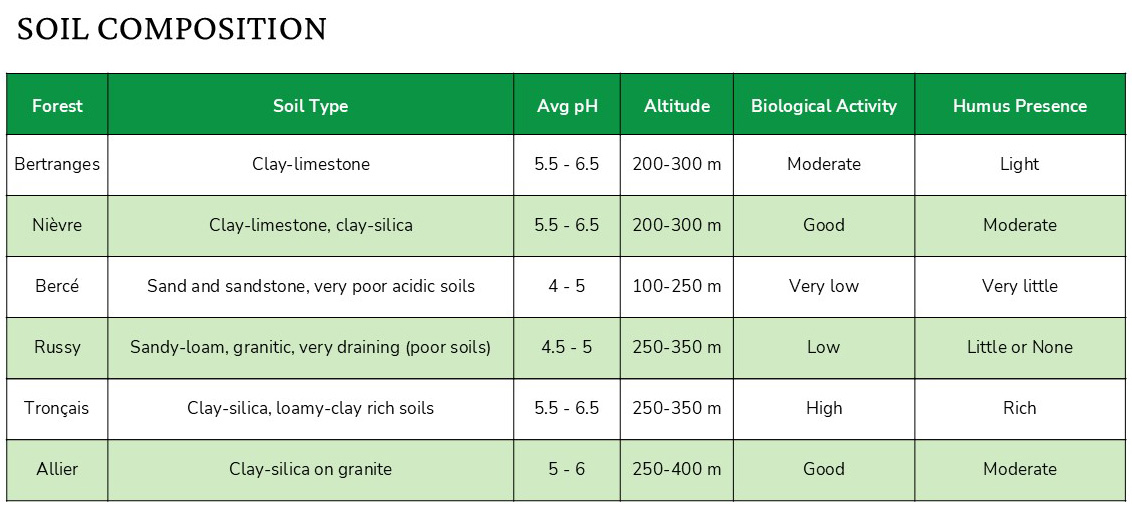
Figure 4 – Forest Soil Composition
Forests like Bertranges and Tronçais are characterized by clay or clay-silica soils and active biological ecosystems, whereas forests like Russy and Bercé have sandier soils and different microbial activity. These variations influence wood chemistry and ultimately affect the expression of the wine.
The age of oak within a forest also contributes to barrel characteristics. In a different study, we compared barrels made with the center part of the tree, the oldest wood, with other barrels made with wood from the periphery of the tree, the youngest wood.
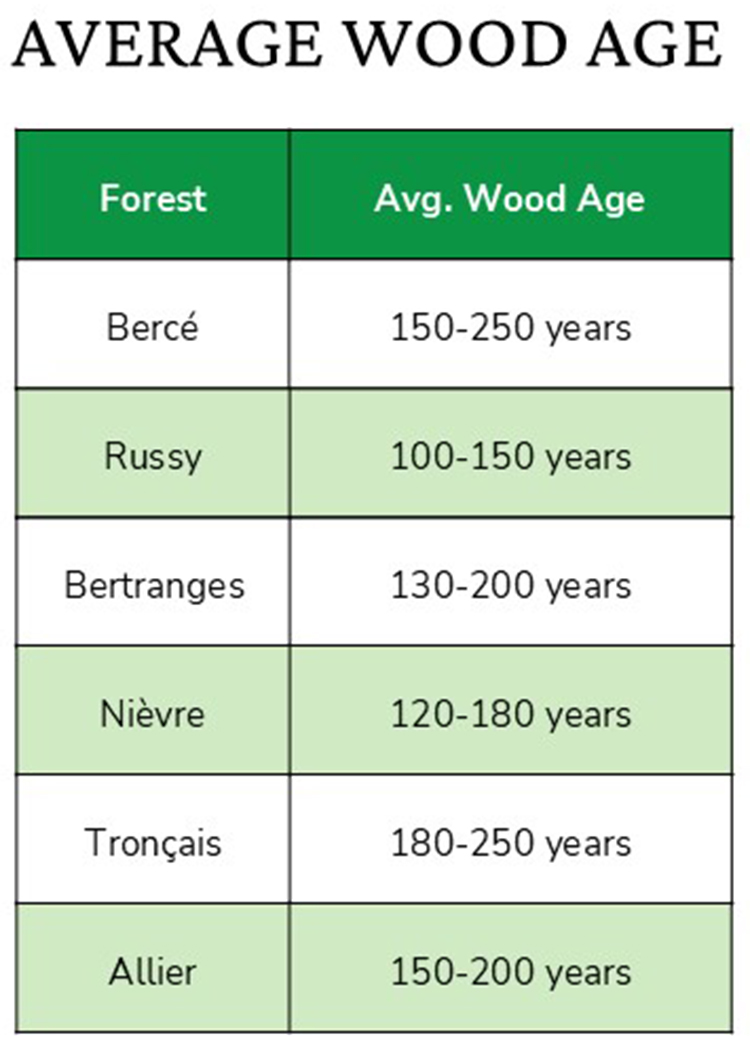
Figure 5 – Average Wood Age of Specific French Forests
We observed significant differences in terms of chemical composition, especially a difference in ellagitannins. Bark, a physical protection to the tree, and the peripheral wood is rich in tannins – a chemical protection from the insect or fungi, or aggressive external threats.
Barrels made with a majority of older, central wood offer lower astringency and finer tannins than barrels made with primarily younger, peripheral wood. Prestigious forests typically contain more mature (older) trees, offering greater consistency and finesse in cooperage.
Species composition of a forest should also be taken into consideration. The selected forests in this study are dominated by sessile oak (Quercus petraea), with Tronçais and Bertranges containing almost exclusively this species. While a small amount of pedunculate oak (Quercus robur) may be present, it plays only a minor role.
Experimental Design
The experiment aimed to evaluate the influence of forest origin on wine using two varietals for chemical and sensory data collection: Pinot Noir and Cabernet Sauvignon (vintage 2023).
For each varietal, two different TW Boswell toasts were used:
- For Pinot Noir: Côte d’Or and Dark Fruit
- For Cabernet Sauvignon: Médoc and Elevate
Each toast was tested with four forest modalities:
- Nièvre
- Tronçais
- Allier
- Blend (Bercé, Russy, Bertranges)
The experiment’s objectives were to:
- Measure the influence of each forest on wine
- Determine whether forest effects persist regardless of varietal or toasting process
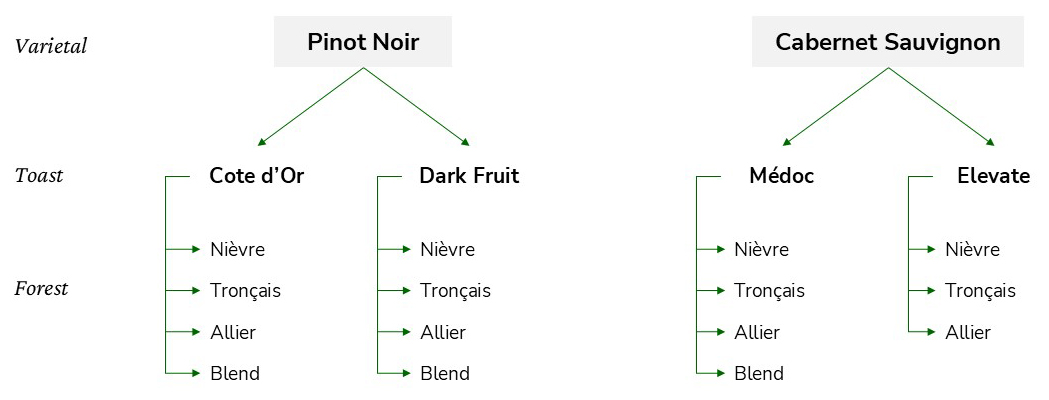
Figure 6 – Experimental Design
Chemical Analysis
The chemical study focused on three compound families:
- Oak aromatics: compounds derived from wood during toasting
- Esters: fruity compounds formed during winemaking
- Terpenes: floral, fresh, and citrus aromas from grapes and oak
Oak Aromatics
We first focused on the oak aromatics – compounds mainly produced during the toasting process. We analyzed six key oak-derived aromatic compounds:
- Lactones (cis- and trans-whisky lactone), which impart coconut aromas
- Eugenol, associated with clove aromas
- Furfural, contributing toasted notes
- Guaiacol, associated with smoked spice notes
- Vanillin, which imparts a vanilla aroma
- Ellagitannins, wood-derived tannins
A multivariate Wilks’ Lambda analysis confirmed statistically significant effects from forest, toast, and varietal (p < 0.05). Based on the p-value, the varietal is the most influential parameter, followed by the toast. Forest origin, though less impactful than toast or varietal, nonetheless contributed meaningful variation to wine aroma.
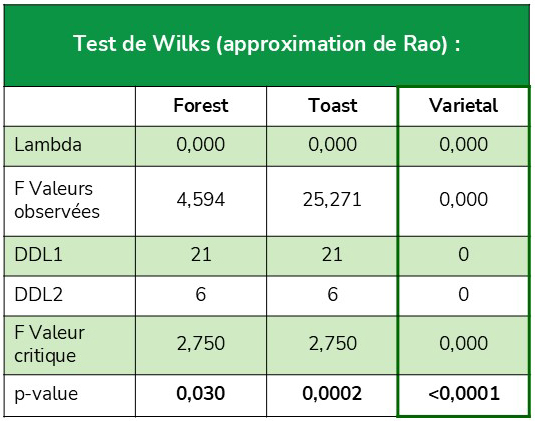
Figure 7 – Chemical Results of Oak Aromatics
These results validate the hypothesis that the origin of the forest contributes to aromatic variation, even if the effect is less pronounced than that of toasting or grape variety. It confirms that forest expression is real and should be considered as a relevant parameter when selecting barrels.
The Principal Component Analysis (PCA) in figure 8 clearly shows the impact of toasting on the aromatic profile on the Pinot Noir and Cabernet Sauvignon. We have two different clusters for Pinot Noir – the Dark Fruit cluster and the Côte d’Or cluster – showing the toast is a big driver in the composition of oak aromatics. This confirms that the toasting profile remains a key factor in shaping the derived aromas, even in a more robust varietal like Cabernet Sauvignon. The effect of the forest origin that we see is also present, but more subtle.
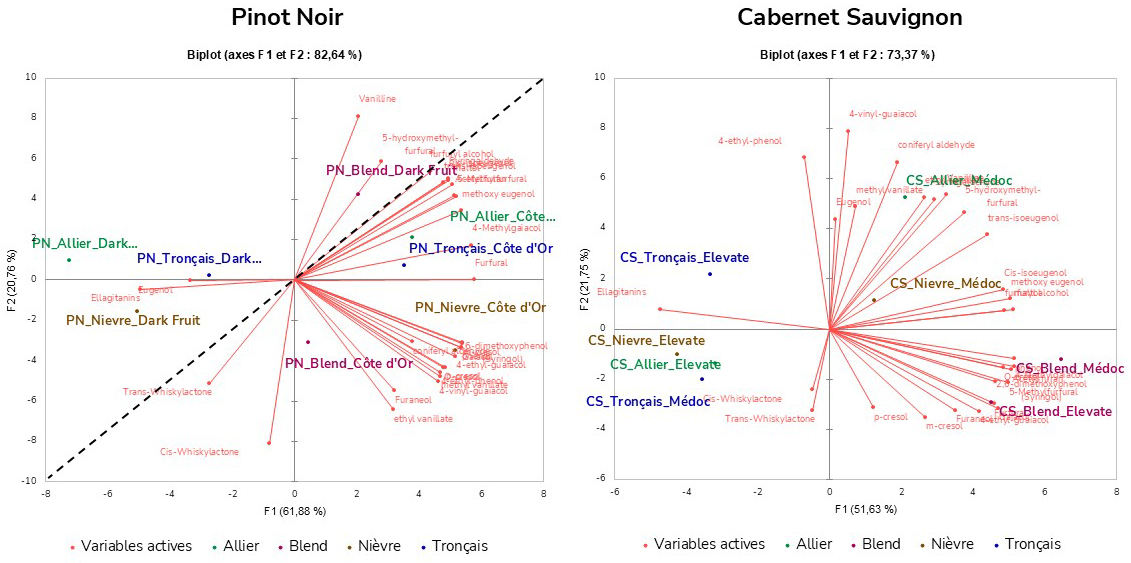
Figure 8 – Oak Aromatics PCA Analysis
Figure 9 is the same PCA without the aromatic compounds to highlight the forest modality. What we observe is that the blend modality, which combines oak from three different forests, consistently displays a slightly different profile compared to the single forest barrels. This trend appears in both Pinot Noir and Cabernet Sauvignon.
We can also note that the Allier and Tronçais are quite close on the chart regarding the oak aromatics, suggesting a similar chemical composition reflecting their geographic and climatic similarities.
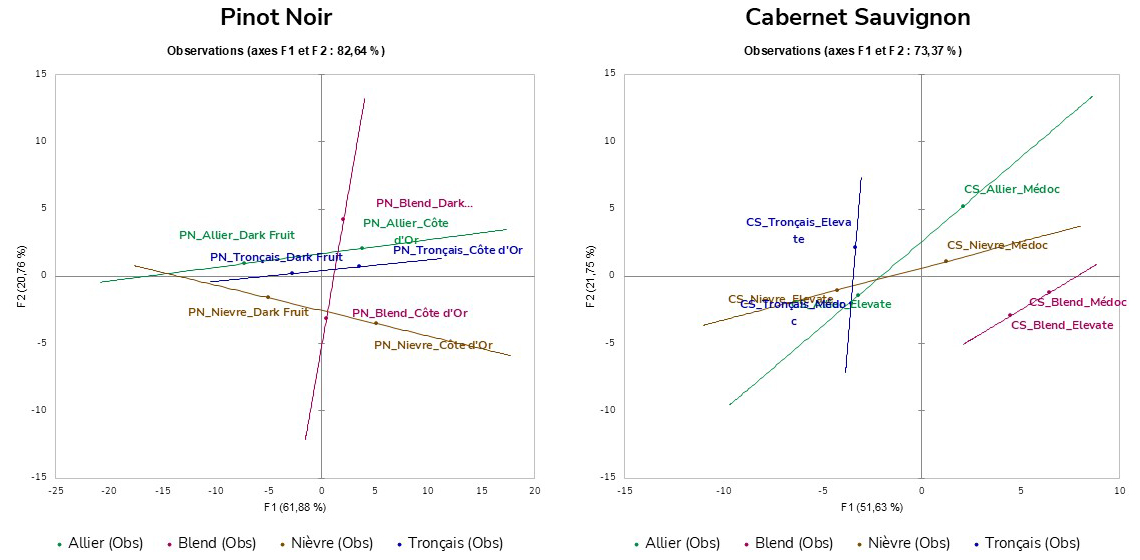
Figure 9
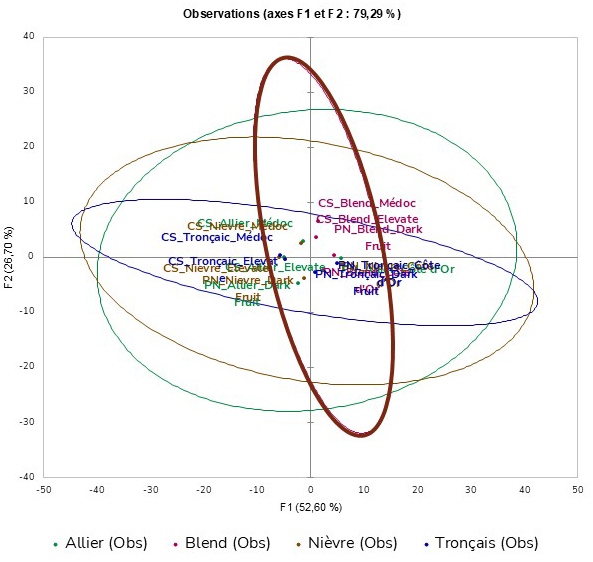
Figure 10
Figure 11 shows the concentration of tannins in the wines, expressed as ellagic acid equivalents. The data reveal three distinct analytical profiles. First, wines aged with the “blend” forest wood show the lowest tannin concentrations across both varietals regardless of toast. Next, Allier and Nièvre form a cluster with intermediate tannin levels. Finally, Tronçais wood exhibits the highest concentration of ellagitannins.
It is important to clarify that when we state Tronçais has the highest ellagitannin concentration, we are comparing only sessile oak samples. This higher concentration does not necessarily translate to a stronger tannin sensation in the mouth. In fact, all forests studied produce a very soft mouthfeel impact. However, when focusing specifically on tannin composition, this trend among the different forests becomes clear.
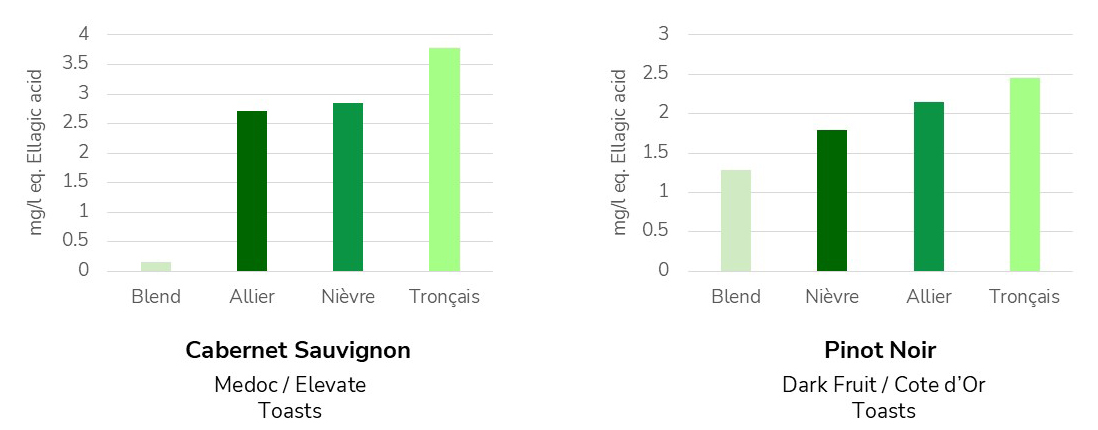
Figure 11 – Ellagitannin Analysis
Esters
The second chemical family analyzed was esters which are responsible for fruity aromas. Two groups of esters were studied in this experiment.
The first group of esters (chemical analysis in Figure 12) showed no differences with respect to toast or forest origin, only a strong varietal effect (Pinot Noir vs. Cabernet Sauvignon).
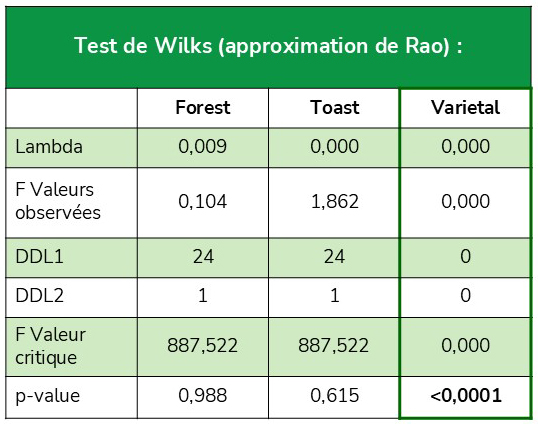
Figure 12 – Figure 12 – Chemical Results for Ethyl 2-Methylbutyrate, Ethyl isovalerate, Isoamyl acetate,
Ethyl hexanoate, Ethyl octanoate, Ethyl decanoate, Phenyl ethyl acetate, Ethyl dodecanoate
The second group (including ethyl-3-hydroxybutyrate, methyl salicylate, and ethyl salicylate) showed a strong varietal effect and a significant toasting effect, but once again, no forest effect.
Figure 13 presents the statistical analysis of the second group of esters:
- Ethyl 3-Hydroxybutyrate – associated with fruity, grape, and pineapple-like aromas
- Methyl salicylate – a strong, minty, sharp, and pleasant scent
- Ethyl salicylate – fresh, mentholated, and agreeable notes
All three compounds are frequently used in perfumery due to their expressive aromatic properties.
Looking at the result of the P-Value in Figure 13, we can see that we have a varietal impact, but we also have a huge toasting impact. Esters are not present in wood, but the toast impacts the formation of esters.
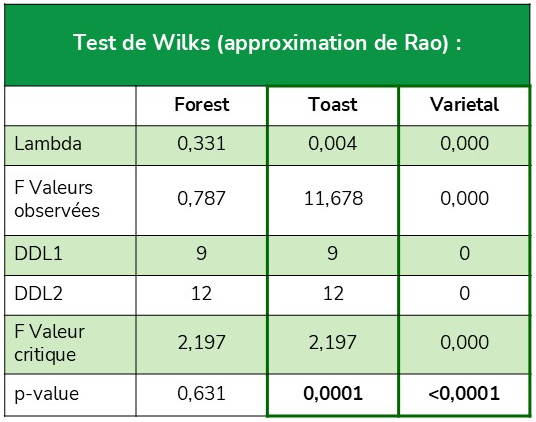
Figure 13 – Chemical results for Ethyl-3-Hydroxybutyrate, Methyl-salicylate, Ethyl-salicylate
Esters formed during barrel aging do not come directly from the oak. They are the result of slow chemical reactions between acids extracted from the wood and alcohols naturally present in wine. Through the toasting process, we can modulate the fruity character of the wine by influencing ester formation. This is why certain barrels are known to enhance the fruitiness of wine — because the toasting process can be targeted to promote the development of specific esters.
It is important to note that the forest origin of wood has no impact on the concentration of esters. In other words, forest origin does not influence the fruity compounds in wine.
Terpenes
Finally, we examined the third chemical family: terpenes. Terpenes are associated with floral, citrus, and fresh aromas and they naturally exist in both grapes and oak. They play a key role in the defense mechanism and in the chemical communication of the trees. Recent studies1-3 show that certain terpenes at low concentration, even far from their perception threshold, can significantly enhance the perception of the fruity notes – especially esters.
Terpenes are sensitive to aging processes. Over time, they can be absorbed by oak surfaces or degrade through oxidation and micro-oxygenation. Nevertheless, careful forest selection and toast management can help preserve them to maintain varietal typicity and the aromatic freshness of the wine.
In our trial, we analyzed four key terpenes4 on both Pinot Noir and Cabernet Sauvignon:
- Alpha-Terpineol – floral lilac, pine
- Citronellol – citronella, rose, green
- Nerol - rose, fruity, floral
- Linalool - citrus, floral, lavender
For the first terpene, Alpha Terpineol, we observed a similar trend across both varietals. We can see that we have a noticeable difference between the blend modality and the Allier modality.

Results in μg/L
Figure 14 – Alpha-Terpineol (Floral, Lilac, Pine)
The second terpene we analyzed is citronellol. We observe the same overall trend, but this time, the blend modality shows higher
concentration in citronellol levels compared to the other barrels.

Results in μg/L
Figure 15 – Citronellol (Citronella, Rose, Green)
The trend is slightly less pronounced for nerol, but once again it remains consistent across both varietals.

Results in μg/L
Figure 16 – Nerol (Rose, Fruity, Floral)

Results in μg/L
Figure 17 – Linalool (Citrus, Floral, Lavender)
Naturally, we ask ourselves whether the toasting process might be involved in this variation because it was one of the points we wanted to validate. If we take linalool as an example, we can see in figure 18 that regardless of the toasting profile, we have the same trend.
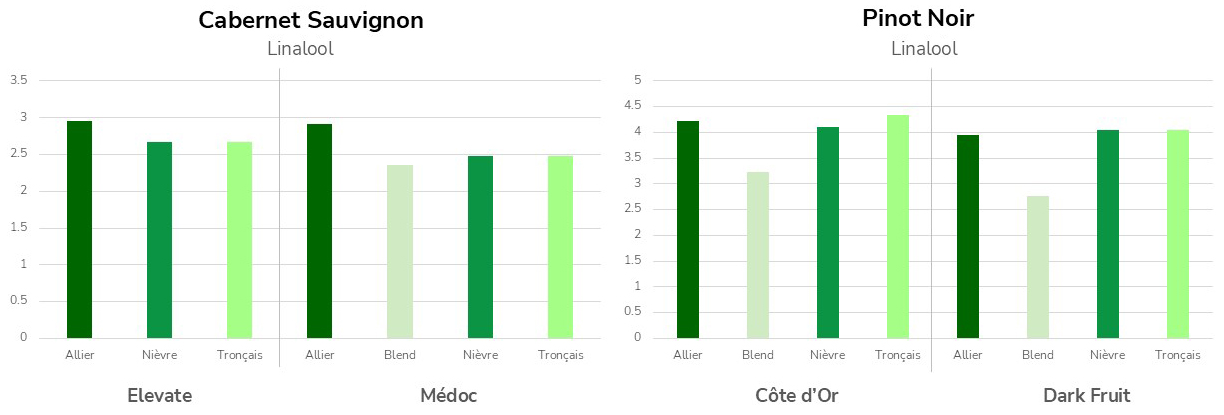
Results in μg/L
Figure 18 – Linalool across toasting profiles
When we look at all the data, the level of variation observed can differ significantly depending on the toasting process. This is precisely why the toast has a meaningful impact. We know that when a high-intensity toast is applied, the variation in characteristics of the forests can become much less noticeable. That’s a key factor to keep in mind: if the goal is to highlight the forest origin, it’s essential to select a low or medium toast level.
In this case, we chose to apply a medium plus toast. The reason was to determine whether, at this level of toasting, we could still observe differences. The results confirmed that even at a medium plus toast, variations are detectable. This suggests that with medium or low toast, the differences between forests would likely be even more pronounced.
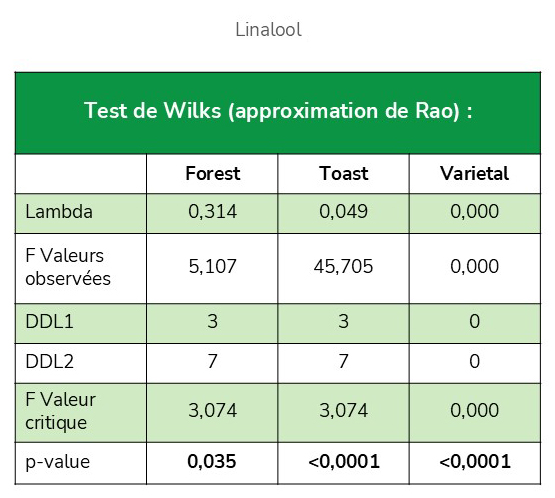
Figure 19 – Linalool
Among the compounds we analyzed, only linalool showed a statistically significant result. However, the variation trends we observed were consistent across both varietals each time, supporting the idea of a forest effect. It’s important to remember that these tests were conducted using a medium plus toast. This suggests that the results could remain significant — and potentially even more pronounced — if a medium or low toast were used.
To conclude this section, we can highlight a few key trends:
- Allier tends to bring more floral notes, such as rose, citrus, and general freshness.
- Tronçais and Nièvre show a better overall balance across all terpenes, creating subtle freshness
- Tronçais, in particular, presents a much higher concentration of linalool compared to other forests, indicating a strong forest influence on floral freshness.
- The blend shows a different terpenic profile altogether, with higher levels of nerol, contributing to notes of orange blossom, rose, and fresh fruit.
Altogether, these results show that each forest imparts a distinct terpenic profile, offering different nuances and aromatic expressions.

Figure 20 – Terpene Profile of Forests
Sensory Results
A sensory tasting was organized with six tasters under blind test conditions for the forest. Participants were asked to describe
the sensory characteristics of each forest sample using their own descriptors, rather than selecting from a predefined list. This
approach was intended to encourage the generation of new descriptors and to explore whether a broader range of terms could
better explain the differences observed between forests.
The results were compiled into bar charts, illustrating the frequency with which each descriptor was cited. For example, in
reviewing all tasting sheets, the “blend” forest received five citations for the descriptor “integrated,” while “Allier” was cited six
times for the same term. Across all forests, descriptors related to a terpenic profile, such as “fresh” and “floral,” were commonly
noted. Notably, “floral” was cited more frequently for Tronçais than for the other forests, likely due to a higher concentration of
linalool found in Tronçais wood.
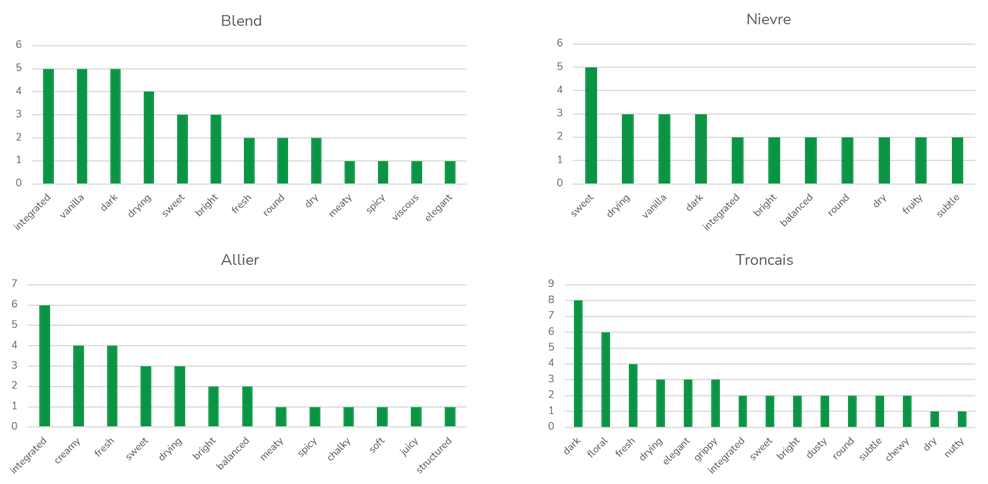
Figure 21 – Sensory Analysis Results
Conclusion
In this study, we explored the influence of specific French oak forests — each with its own history, terroir, and growth conditions — on wine aging. These forests produce oaks with a distinct composition, particularly in terms of aromatic precursors and tannin potential.
To illustrate these differences, we conducted a comparative trial across two matrices (Pinot Noir and Cabernet Sauvignon) and two toast levels, analyzing:
- Oak aromatics (wood-derived compounds)
- Esters (fruitiness)
- Terpenes (floral and freshness notes)
Our conclusions are as follows:
- Grape variety remains the dominant driver of the wine’s aromatic profile (as expected and desired).
- Toasting exerts a strong influence on oak aromatic expression and ester formation.
- Forest origin exerts a subtle but meaningful effect, particularly through contributions to floral freshness via terpenes.
Thus, forest selection brings nuance and complexity to wine aging, complementing varietal character and toasting style.

------------
Bibliographic references:
- Marais, J. (1983). “Terpenes in the aroma of grapes and wines: a review.” South African Journal of Enology and Viticulture 4(2): 49-58.
- Mahanta, B. P., et al. (2021). “Thermolabile essential oils, aromas and flavours: Degradation pathways, effect of thermal processing and alteration of sensory quality.” Food research international 145: 110404.
- Garbay, J., et al. (2025). “Investigating the Olfactory Impact of Monoterpenic Compounds on Fruity Aroma Perception in Model Red Wine Solutions.” Journal of Agricultural and Food Chemistry 73(7): 4208-4218.
- aBlack, C. A., et al. (2015). “Terpenoids and their role in wine flavour: recent advances.” Australian Journal of Grape and Wine Research 21: 582-600.
